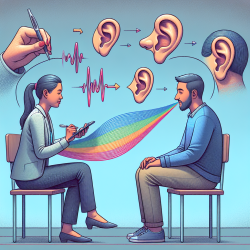Understanding Nasal Resonance in Hearing Impaired Adults
The study "Characteristics of Nasal Resonance and Perceptual Rating in Prelingual Hearing Impaired Adults" provides significant insights into the unique speech characteristics of individuals with hearing impairments. This research is crucial for speech-language pathologists who aim to enhance their therapeutic interventions for hearing-impaired clients.
Key Findings from the Research
The research highlights that hearing-impaired (HI) individuals often exhibit deviant nasal resonance patterns, which can be categorized into hyper-nasal, hypo-nasal, and mixed-nasal groups. These patterns are assessed using nasalance scores obtained from nasometer readings during specific speech tasks.
Interestingly, the study introduces the 'Vertical Focus of Resonance' (VFR) tool, which offers a perceptual rating of resonance energy focusing in different vocal tract locations, such as the nasal, pharyngeal, and oral cavities. This tool helps explain the deviant resonance patterns in HI individuals, providing a more comprehensive understanding beyond nasalance scores alone.
Implications for Speech-Language Pathologists
For practitioners, the implications are clear: understanding and utilizing the VFR tool can significantly enhance the assessment and treatment of resonance issues in HI individuals. By focusing on the vertical distribution of resonance energy, therapists can better tailor their interventions to address specific resonance dysfunctions.
Moreover, the study suggests that resonance issues in HI individuals cannot be fully explained by nasal resonance alone. Therefore, a holistic approach that evaluates the entire resonance cavity is essential for accurate diagnosis and effective treatment planning.
Encouraging Further Research
While the study provides a robust framework for understanding resonance issues in HI individuals, it also opens avenues for further research. Future studies could explore the 'horizontal focus of resonance' to provide even deeper insights into the speech characteristics of HI individuals. Additionally, developing objective methods for analyzing horizontal resonance focus could enhance the accuracy of assessments.
Conclusion
Incorporating the findings from this research into clinical practice can lead to improved speech outcomes for hearing-impaired clients. By adopting a comprehensive approach to resonance assessment, practitioners can more effectively address the unique challenges faced by this population.
To read the original research paper, please follow this link: Characteristics of Nasal Resonance and Perceptual Rating in Prelingual Hearing Impaired Adults.










